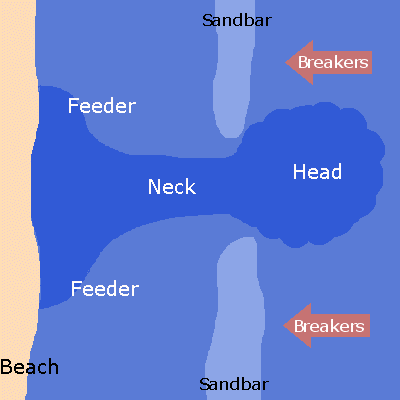
Current situation on the beach
Breakwaters and rip currents
Rip currents
The sea may look safe, but it is not! It is full of rip currents that pull you from the mainland, into sea. These currents are often too strong for swimmers to swim against, back to the shore. They are the result of the interaction between the waves and bottom of the sea.
What does it look like?
Our sea consists of breakwaters, sea banks and rip currents. Rip currents exist around the breakwaters. When you look at the sea, you can spot them. You will see spots where there is whitewash and where there is none. Waves form whitewash when they hit a sandbar. This is a safe place to swim. At the spots where there is no whitewash, the sea is deeper and currents exits. DO NOT SWIM HERE! These are the dangerous currents! In the pictures below , you can see an example of these currents (left) and the flow of the currents (right)


What to do when in a rip current?
First, DO NOT PANIC! To get out of a rip current, do not swim directly to the shore! The current is always stronger than you are! Swim to the side (left or right), parallel along the beach. Try to alert the people at the beach and the lifeguards by waving, for instance. When you see someone in trouble, do NOT go after them. You will endanger yourself and maybe drown! You can see an example in the picture below.

Breakwaters
On our beach are breakwaters. The breakwaters consist of basalt blocks. On these blocks, algae grows which makes it very slippery. The breakwaters are only visible when the water is low enough and disappear when the tide comes in. Do bear in mind that you can still hit them! Waves can hit you and smack you on the rocks. This is very dangerous.

How do I recognise them?
On the shoreline, there are signs which indicate where the breakwaters are. These warn the visitors where they are